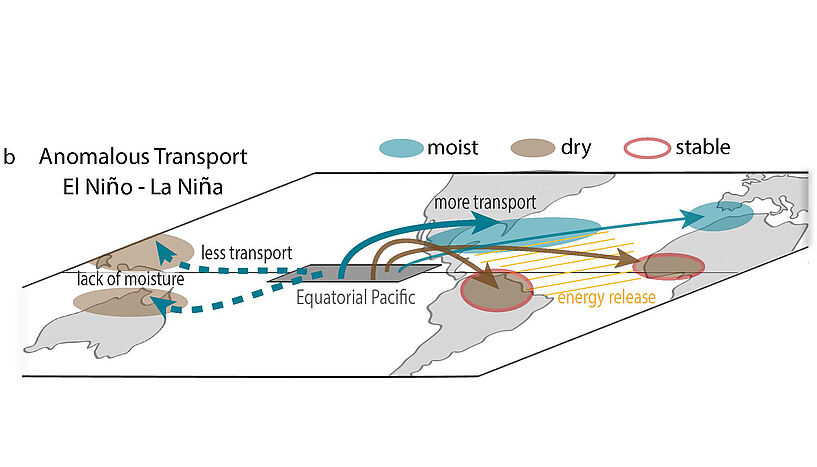Transport of air masses in connection with "El Niño" decoded
06. December 2022Viennese meteorologists: Transport of air mass from the Pacific Ocean explains weather conditions associated with El Niño in North America, South America and Australia
The El Niño phenomenon influences the weather in distant regions, as far away as the USA, India or the Mediterranean region. But how exactly these so-called teleconnections actually work has not yet been clarified completely. Atmospheric researchers at the University of Vienna have now succeeded in demonstrating that variations of the transport of air mass, heat, moisture and energy from the tropical Pacific are responsible for many of these climate anomalies. And: El Niño also warms up the Atlantic, according to the study recently published in the journal "Geophysical Research Letters".
The El Niño Southern Oscillation (ENSO) is one of the most important modes of climate variability worldwide, with large impacts on the weather conditions in many regions, and thus on agriculture and economy. It is related to changes in the sea surface temperatures in the Tropical Pacific Ocean. Periods with higher temperatures cause the so-called El Niño phenomenon. This phenomenon causes pronounced weather anomalies in many regions around the world, for example, droughts in the Amazon basin. These far-ranging impacts are called teleconnections.
Breakthrough regarding the role of air mass transport
Despite of a lot of research that has been done on ENSO, the mechanisms behind the observed teleconnections are still not well understood. Researchers at the University of Vienna now made a breakthrough in our understanding of the role of air mass transport in these teleconnections. They found that variations of the transport of air mass, heat, moisture and energy from the Tropical Pacific are causally responsible for many of the observed climate anomalies.
Katharina Baier, first author of the study and Early Career Researcher at the Department of Meteorology and Geophysics of the University of Vienna, explains: "The main benefit of our study is the different perspective on teleconnections, as we look at how the heat and moisture from the Pacific Ocean is transported via the atmosphere. We can thus establish a direct connection between the Pacific and remote regions. For instance, we can show that anomalously dry air is transported towards the Amazon Basin during El Niño, causing droughts there. In contrast, anomalously moist air is transported toward the southeastern U.S., which favours increased precipitation."
El Niño is also warming the Atlantic ocean
Andreas Stohl from the University of Vienna, who has led the study which is now published in the Journal Geophysical Research Letters, points out: "Our results contribute to the understanding of weather phenomena worldwide, for instance also in Australia, Africa, or the Mediterranean. In addition, we can show that anomalously large amounts of heat are transported from the Tropical Pacific towards the Atlantic Ocean during El Niño, which then responds by warming." Stohl is also head of the Department of Meteorology and Geophysics as well as the Research Network "VINAR".
Methodologically, the research team at the University of Vienna relied on atmospheric dispersion models, the so-called Lagrangian models. While conventional models record meteorological parameters such as humidity or temperature at certain positions, Lagrangian models follow the individual particles and capture how the meteorological parameters change along their way. These models can also be used to analyze the dispersion of particles such as soot, microplastics, or greenhouse gases.
This study was supported by the Dr. Gottfried and Dr. Vera Weiss Science Foundation and the Austrian Science Fund in the framework of the project P 34170-N, "A demonstration of a Lagrangian re-analysis (LARA)".
Publication in Geophysical Research Letters:
The role of atmospheric transport for El Nino-Southern Oscillation teleconnections. K. Baier, M. Duetsch, M. Mayer, L. Bakels, L. Haimberger and A. Stohl (2022). In: Geophysical Research Letters
DOI: 10.1029/2022GL100906
Figures:
Fig. 1: Summary of atmospheric transport from the Tropical Pacific Ocean. Solid arrows show an increase in mass transport during El Niño; dashed arrows a decrease. Blue arrows show the transport of relatively moist air to anomalously moist local conditions (marked with blue shading), while brown arrows show transport of dry air to anomalously dry local conditions (brown shading). Red circles show transport of warm air aloft that favors stable conditions. Orange shading shows transport of anomalously greater amount of heat from the Pacific Ocean to the Tropical Atlantic. Copyright: Baier et al. 2022, Geophysical Research Letters. CC BY 4.0
Fig. 2: Katharina Baier (C: Barbara Mair)
Fig. 3: Andreas Stohl (C: Barbara Mair)
Links:
VINAR - Vienna Network for Atmospheric Research - https://vinar.univie.ac.at/
Department of Meteorology and Geophysics - https://img.univie.ac.at/en
Scientific contact
BSc MSc Katharina Baier
Institut für Meteorologie und Geophysik, Universität Wien1090 - Wien, Josef-Holaubek-Platz 2 (UZA II)
+43-1-4277-53734
k.baier@univie.ac.at
Univ.-Prof. Mag. Dr. Andreas Stohl
Institut für Meteorologie und GeophysikUniversität Wien
1090 - Wien, Althanstraße 14 (UZA II)
+43-1-4277-53730
andreas.stohl@univie.ac.at
Further inquiry
Theresa Bittermann
Media Relations, Universität Wien1010 - Wien, Universitätsring 1
+43-1-4277-17541
theresa.bittermann@univie.ac.at
Downloads:
20221206_ElNino_Abb1_01.jpg
File size: 129,38 KB
20221206_ElNino_Abb2_01.jpg
File size: 1,82 MB
20221206_ElNino_Abb3_01.jpg
File size: 5,86 MB



